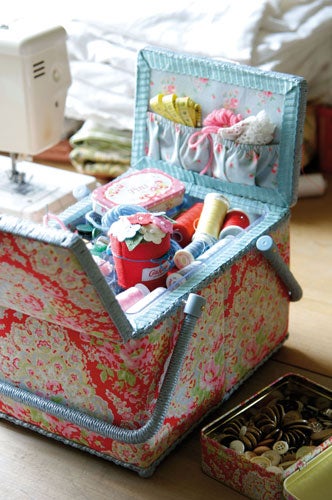Why granny would approve
Thrift is hip, says Annie Deakin. Gone are the days of throwaway fashion as the long-forgotten era of make do and mend is back

Your support helps us to tell the story
From reproductive rights to climate change to Big Tech, The Independent is on the ground when the story is developing. Whether it's investigating the financials of Elon Musk's pro-Trump PAC or producing our latest documentary, 'The A Word', which shines a light on the American women fighting for reproductive rights, we know how important it is to parse out the facts from the messaging.
At such a critical moment in US history, we need reporters on the ground. Your donation allows us to keep sending journalists to speak to both sides of the story.
The Independent is trusted by Americans across the entire political spectrum. And unlike many other quality news outlets, we choose not to lock Americans out of our reporting and analysis with paywalls. We believe quality journalism should be available to everyone, paid for by those who can afford it.
Your support makes all the difference.Last week, my father asked me to find him leather elbow patches to mend his hole-y woollen sweater. The ancient garment was almost threadbare but it didn’t cross Dad’s mind to chuck it and buy a new one. I thought it rather sweet and quaint but later cottoned on that his self-sufficiency is not exclusive to his generation. The "Make Do and Mend" movement, powered by the thrift trend, is taking the fashion and design world by storm. A reluctance to buy new is dominating what has previously been a throwaway culture.
Search for the perfect furniture with The Independent house and home database, powered by mydeco.
The economic malaise is a loud wake-up call to the consumer bubble. We want to make our lives more sustainable by making and mending stuff, rather than buying more stuff. Eight months ago, if I broke a kitchen appliance, I’d replace it with a new model without thinking. Why fix something when it’s probably cheaper to bin it for a new model? But this blasted recession is teaching all of us, myself included, to make do and mend. We were treating our belongings as disposable and upgradable but now the handmade and mended is king. We want longetivity. Online marketplaces for handmade goods, like Etsy and mydeco.com's design boutique, are seeing a rise in listings and transactions.
"People who haven't woken up to the need to economise are going to soon," said Robert Opie, curator of the Museum of Brands, Packaging and Advertising in Notting Hill. "In the 1940s everyone had to take responsibility; it binded people together and they were able to pull together as a result." Next week, Opie is opening an exhibition Waste Not, Want Not to remind people how times were during the Second World War. "They will see how it was, how they overcame it and show it can be done again."
This new way of thinking is an unexpected return to scrimping values and repair trends. Cobblers, tailors and furniture repair specialists are among the few who are holding strong in this uncertain retail market. Instead of buying new, Dad recently upholstered two tatty old chairs with pretty tapestry. Bryonie Porter, a former masseuse, is on his wavelength; Instead of throwing out her old desk five years ago, she covered it in floral wallpaper from Osborne & Little. Porter now sells re-covered old furniture sale - for one client, she wallpapered the units in a camper van. She shows we can save without scrimping on style.
There's a lesson in Porter's madness: flair and imagination makes even small-budget changes more effective. My friend Bix (weirdly also a masseuse) is decorating her new Barons Court flat on a shoestring budget; instead of splurging on expensive art, she is framing pretty wallpaper and music manuscripts. She could decoupage entire walls with photographs, letters, deeds and family history documents.
Hysterically, doctors are recommending crafting as a major form of stress relief. A recent study showed that knitting, no longer a fusty affair, is one of the best ways to beat the recession blues. Led by keen knitters Kate Moss and Julia Roberts, there's a growing number of twenty-somethings with attitude who knit regularly. These style-conscious young, who previously wouldn’t have been seen dead holding needles (knitting ones, that is), meet up at groups called Stitch n'Bitch and I Knit London.
"Knitters are rebels,” says Rachael Matthews, founder of knitting group, Cast Off. "A knitter doesn’t have to shop: they don't ask for permission, they are practical people who can just get on and do it.” Matthews caused a scene in 2003 by knitting in the Savoy bar.
Danielle Proud, author of House Proud: Hip craft for the modern homemaker, simultaneously attacks mass consumerism and fustiness. "'Traditionally, craft was a nesting pastime, as housewives would make do and mend. Now, it’s an expression of creativity," says Proud. "And your gran would fall off her rocking chair if she saw how we’re sticking two fingers up at how it used to be done."
As we look for inexpensive ways to entertain ourselves, the month's launch of The Knitter, a niche 100-page glossy magazine, was timely. Cath Kidston, who was inspired by the make do and mend ethos of post war design, sells knitting sets. Her sewing baskets are a bestseller. Making do and mending is a reaction against the mass market. It’s only by sitting down and making something yourself do you realise the time and effort that goes into design.
I can't see Dad knitting quite yet but sewing on patches is a pretty good start. "To make or customise your own things gives you a real sense of achievement," says Kidston: "That feeling of self-worth is better than anything, don’t you think?"
Join our commenting forum
Join thought-provoking conversations, follow other Independent readers and see their replies
Comments